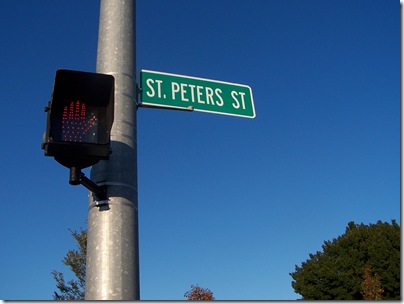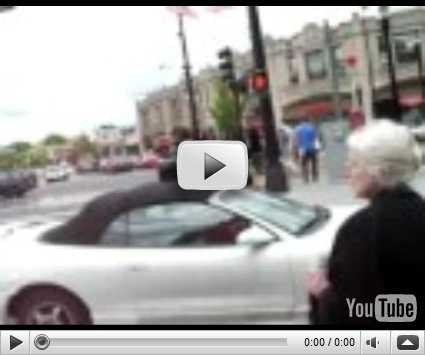Robert Moran writes another column on my neighborhood . He has a comment on the small (unnamed) park outside my building:
In front of the old jail, on the corner, a park was born this month. With wild flowers, shade trees and a couple of benches, it is already a stroll-through for Salemites. It provides excellent vantage to enjoy pigeon games and watch Bridge Street traffic integrate with the new bypass.
To prevent lingering, road builders installed a god-awful pedestrian crossing bell at St. Peter and Bridge. If annoyed park sitters find the bell irritating, they might pity the tormented residents of Morency Manor and Jefferson Apartments. A stone’s throw from their windows, builders installed additional (deci) bells.
It is indeed annoying and frustrating but not deliberate. I have a long history with that particular pedestrian signal.
Over two years ago, I and the Salem Commission on Disabilities (myself, Jack Harris, Charlie Reardon, Andy LaPointe and the mayor’s chief of staff Jason Silva) met with the bypass road’s project director, Sue Cranney of MassHighway.
We wanted “talking” pedestrian signals, made by Polara Engineering, at St. Peter’s St. We had wanted these also at Bridge and Washington St. at the train station, but we were told (in 2006) that the signals were already ordered, so we focused our attention on St. Peter’s St., which would not be completed until the end of the project two years later.
Ms. Cranney agreed to our request and told us the extra cost upfront would not be an issue to her budget. We had every reason to believe that
Fast forward to now. As soon as I saw the ringing signal—which was not what we asked for—my chairman, Jack, contacted Ms. Cranney. She told him the signal was in compliance. This is technically correct.
But the Polara signal has already been used in MassHighway projects in Salem! You can find these talking signals at Marlborough Rd., Vinnin Square, and most notably at Salem State College’s Central Campus opposite Jefferson Ave.
I have been left to wonder why MassHighway would use the Polara signals in some locations but not others. None of the locations of these signals are anywhere near hospitals or other “places for the disabled” (which is usually how accommodations take place when someone feels sorry for the disabled). Marlborough Rd. is a residential area even more so than St. Peter’s St., Vinnin Sq. is a commercial area with few pedestrians. The Polara signal at Jefferson and Loring services busy Salem State College, but the area was merely a residential DMZ between North and South Campus (Central Campus did not yet exist) when the signal was installed.
MassHighway recently rebuilt the busy Coolidge Corner intersection in Brookline with Polara signals. Here’s what they look and sound like:
These signals adjust their volume to overcome ambient noise and to be quiet at night. They wouldn’t disturb people on my corner.
More importantly, they are more vandal-proof than other pedestrian controls and are cheaper to maintain.
MassHighway is trading off their cheap acquisition price for the extra expense that the city will have, once the project is turned over to them.
It is an understatement that I am disappointed in Ms. Cranney.
Many might wonder, why do we need these signals in Salem? We’re not Brookline.
Or are we?
Coolidge Corner is a busy place for pedestrians going to and from businesses and the trolley down the middle of Beacon.
Washington St. and Bridge St. is busy with pedestrians. They go from place to place at the intersection. They also go to the train station. Lots of people do.
Since the city and the state have both decided to move forward with the courthouse project, there is and will be much pedestrian traffic, not only at Washington and Bridge but also at North and Federal.
Since the city wants to keep pedestrians moving through downtown Salem, I suggest that Kim Driscoll might make some calls to MassHighway before the project is transferred over.
Oh, and Robert, people live in the neighborhoods you write about. Just saying.


3 comments:
The loud buzzing signal is practically right outside my window. I live at the Jefferson building. Since the signal went into operation, every night as I sleep, the signal goes off frequently. To put it in perspective, this morning, it drowned out the sound of my alarm - it is louder. I haven't had a good nights sleep and am not taking sleeping pills just to stay sane. I'm not sure how one can justify the safety of one group of people over the health of others. To me, this seems selfish.
That's exactly why I want to see the new talking signals there! They adjust their volume automatically to match ambient noise so they won't be loud at night.
In the meantime, I'll see if Mike can get someone out there to adjust the volume on the bell.
Mr. Moisan,
I’ve noticed since my column was published, the city has turned down the volume outside both Jefferson Apartments and Morency Manor. If that was your doing, I’m sure your neighbors appreciate your efforts. (The volume at both ends of the park is still very loud.)
I agree with you. Something more that visual signals is needed at pedestrian crossings. However, their nature (including volume, if it’s an audio signal) has to fit the circumstances of their placement. Placing extremely loud bells in the midst of two residential complexes was clearly inappropriate. I don’t think they fit well in a park setting either, but I can appreciate other points of view.
I was pleased to read that your suggestions for signaling were not as intrusive as are those bells. Nonetheless, there must be better technology than placing ringing, buzzing, or talking noisemakers high on a pole where they have to have sufficient volume to be heard 12 feet below in a 20-foot radius.
Given my druthers, I would want to see something placed in the sidewalk or low to the ground on the pole. If that something made noise, the sound would have to fill a lot less volume. Better, however, would be something like a vibrator in the waiting-to-cross area.
Bob Moran
Post a Comment